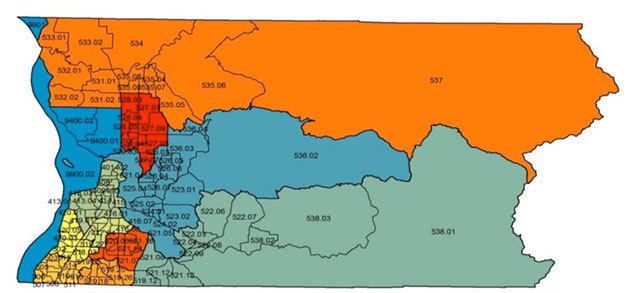A Snohomish Health District report on health trends around the county documents some striking findings on poverty, wealth, births and disease.
Suicide deaths were highest in the Edmonds, Mountlake Terrace and west Lynnwood area. The suicide rate there was 25.2 deaths per 100,000 people far exceeded the county’s overall rate of 16.3 suicides per 100,000 people.
Deaths from Alzheimer’s disease were most prevalent in Bothell and Brier, which had the county’s second highest median household income of $88,600.
Deaths due to complications from diabetes occurred in the Tulalip Bay and north coast areas at more than twice the countywide rate of roughly 26 deaths per 100,000 people.
The health district analyzed medical data in the county and presented the results for 11 distinct geographic areas.
People generally lived to be about 80 years old in Snohomish County. Adults in Bothell and Brier; the Edmonds, Mountlake Terrace west Lynnwood area; and the Sultan, Skykomish and Monroe area live slightly longer, to about 82 years of age.
The lowest life expectancy, 73 years, was in the Tulalip area.
The study was based on an analysis of information from the state Department of Health and the U.S. Census Bureau. It is an in-depth look at the health problems faced by people living here and how those problems differ from community to community. It took about six months to complete.
When looking at the findings from the geographic areas, “it’s very clear there are tremendous differences in the demographics and the health of the folks who live in those areas,” said Dr. Gary Goldbaum, health officer for the Snohomish Health District.
Deaths from unintentional injury were highest in the Arlington, Stanwood and Darrington area, with 86.3 such deaths percent 100,000 people — double the countywide rate.
Nearly 8 percent of people in Edmonds, Mountlake Terrace and west Lynnwood were reported living in poverty. Even higher levels were found in south Everett (13 percent) Tulalip (11 percent) and in north Everett (10.4 percent).
For many factors examined, lower income equated to poorer health, the study found.
Teen birth rates were highest in Marysville and the north and south Everett areas, all exceeding the countywide rate of 14.6 births per 1,000 15- to 19-year-olds.
Infant mortality rates were highest for families from the Tulalip Bay and north coast area, Marysville, north Everett, Edmonds, Mountlake Terrace and west Lynnwood areas. All exceeded the county-wide rate of 3.6 deaths of infants per 1,000 live births.
Overall, single parents make up nearly 27 percent of all households in the county. The communities with the highest percent of single-parent households were north and south Everett, Edmonds, Mountlake Terrace, Lynnwood, Mukilteo and Tulalip.
Heart disease claimed the most lives among people living in south Everett, Tulalip, Arlington, Stanwood and Darrington. Death rates from cardiovascular disease in all these areas exceeded the county’s typical rate of roughly 190 deaths per 100,000 people.
Cancer death rates were highest in Tulalip, Mill Creek, Sliver Firs, Granite Falls, Lake Stevens and Snohomish areas.
In general, health was best in communities with the highest median household incomes, including Mill Creek and Silver Firs ($100,390), Bothell and Brier ($88,600), and Skykomish Valley communities from Monroe eastward ($81,659). But as the cancer rate demonstrates, that isn’t universally true.
“Public health’s job is to call attention to what the issues are and help communities take charge of the things that need to be done locally to improve health,” Goldbaum said.
For instance, more cities could consider making parks smoke free, he said, a step aimed at helping reduce the number of people who smoke.
Assuring that kids have safe routes to walk or bike to school can be a step in instilling lifelong healthy habits, Goldbaum said.
The health district will report more health data in the coming weeks, comparing the health trends in Snohomish County with those in communities statewide and nationally.
Goldbaum said he expects Snohomish County to stack up pretty well in those studies. But the focus should remain on both the economic disparities and differences in health in the area’s communities, he said.
“I think it’s really critical to be aware of these tremendous differences and to take advantage of this information to really focus on how to improve the health of every community,” Goldbaum said.
Sharon Salyer: 425-339-3486; salyer@heraldnet.com.
Info:
Details on the trends found in the 11 health reporting areas are available at http://bit.ly/29IFOA2.
Talk to us
> Give us your news tips.
> Send us a letter to the editor.
> More Herald contact information.

























